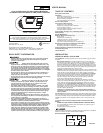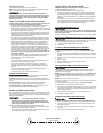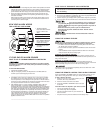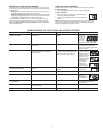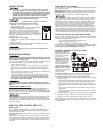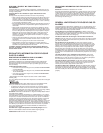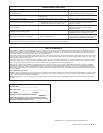
I
MPORTANT! PLEASE READ CAREFULLYAND SAVE.
This unit was shipped with a user’s manual that contains important
information about its operation. If you are installing this unit for use by others,
y
ou must leave this manual—or a copy of it—with the end user.
T
ABLE OF CONTENTS
Basic Safety Information . . . . . . . . . . . . . . . . . . . . . . . . . . . . . . . . . . . . . . . .1
I
nstallation . . . . . . . . . . . . . . . . . . . . . . . . . . . . . . . . . . . . . . . . . . . . . . . . . .1-3
Where To Install This Alarm . . . . . . . . . . . . . . . . . . . . . . . . . . . . . . . . . . .1-2
W
here This Alarm Should Not Be Installed . . . . . . . . . . . . . . . . . . . . . . . .2
Be
fore You Begin Installation . . . . . . . . . . . . . . . . . . . . . . . . . . . . . . . . . . .2
How To Install This Gas/CO Alarm . . . . . . . . . . . . . . . . . . . . . . . . . . . . .2-3
How Your Alarm Works . . . . . . . . . . . . . . . . . . . . . . . . . . . . . . . . . . . . . . . . .3
If
Your Gas/CO Alarm Sounds . . . . . . . . . . . . . . . . . . . . . . . . . . . . . . . . . .3-4
What To Do if CO is Detected . . . . . . . . . . . . . . . . . . . . . . . . . . . . . . . . . .3
W
hat To Do if Explosive Gas is Detected . . . . . . . . . . . . . . . . . . . . . . . . . .3
U
sing the Silence Feature . . . . . . . . . . . . . . . . . . . . . . . . . . . . . . . . . . . . .3
U
sing the Remote Control Test/Silence Feature . . . . . . . . . . . . . . . . . . . .3
Using the Peak CO Memory . . . . . . . . . . . . . . . . . . . . . . . . . . . . . . . . . . .4
U
nderstanding the Light, Horn, and Display Patterns . . . . . . . . . . . . . . . .4
W
eekly Testing . . . . . . . . . . . . . . . . . . . . . . . . . . . . . . . . . . . . . . . . . . . . . . . .5
R
egular Maintenance . . . . . . . . . . . . . . . . . . . . . . . . . . . . . . . . . . . . . . . . . . .5
W
hat You Need To Know About CO . . . . . . . . . . . . . . . . . . . . . . . . . . . . .5-6
What is CO? . . . . . . . . . . . . . . . . . . . . . . . . . . . . . . . . . . . . . . . . . . . . . . . .5
S
ymptoms of CO Poisoning . . . . . . . . . . . . . . . . . . . . . . . . . . . . . . . . . . . .5
F
inding the Source of CO After an Alarm . . . . . . . . . . . . . . . . . . . . . . . . .5
Potential Sources of CO in the Home . . . . . . . . . . . . . . . . . . . . . . . . . . . .5
How Can I Protect My Family From CO Poisoning? . . . . . . . . . . . . . . . . .6
R
egulatory Information For Explosive Gas/CO Alarms . . . . . . . . . . . . . . .6
Regulatory Information for CO Alarms . . . . . . . . . . . . . . . . . . . . . . . . . . . .6
Regulatory Information for Explosive Gas Alarms . . . . . . . . . . . . . . . . . . .6
Genera
l Limitations Of Explosive Gas/CO Alarms . . . . . . . . . . . . . . . . . . .6
Troubleshooting Guide . . . . . . . . . . . . . . . . . . . . . . . . . . . . . . . . . . . . . . . . . .7
Limited Warranty . . . . . . . . . . . . . . . . . . . . . . . . . . . . . . . . . . . . . . . . . . . . . .7
All Rights Reserved. © 2005 BRK Brands, Inc.
BRK Brands, Inc., 3901 Liberty Street Road,Aurora, IL 60504-8122
Consu
mer Affairs: (800) 323-9005 • www.brkelectronics.com
PLUG-IN EXPLOSIVE GAS AND CARBON MONOXIDE
ALARM
WITH BATTERY BACK-UP AND SILENCE
F
EATURE
USER’S MANUAL
Printed in Mexico
M0
8-0123-000
Q 0
5/05
M
odel GCO1
1
20VAC
~ 6
0Hz, 0.25 A
INSTALLATION
WHERE TO INSTALL THIS ALARM
For Gas Alarms, mounting depends on the type of explosive gas you intend
to detect.
Natural Gas (methane) is typically supplied through a main utility line
connected to your home. If you do not live in a rural area you are likely to
be a user of natural gas. Natural gas is a fossil fuel consisting mainly of
Methane. Methane is much lighter than air and will rise rapidly in air. If you
are a user of natural gas, the Alarm should be mounted between 6 and 12
inches (152mm and 305 mm) away from the ceiling (using cord feature) to
ensure the earliest opportunity to detect a leak.
Propane is typically supplied to homes by delivery truck in liquid form and
stored near the home in propane tanks. Propane is used by homes in rural
areas that do not have natural gas service. Since propane is the most
commonly used Liquefied Petroleum Gas (LPG),
propane and LP-Gas are
often used synonymously. Unlike natural gas, propane is heavier than air
and will collect at lower levels. If you are a user of propane, the Alarm
should be mounted near the floor (using the direct plug-in feature) to
ensure the earliest opportunity to detect a leak.
Both propane and natural gas are colorless and odorless. For safety
reasons, an ordorant (Mercaptan) is added so that any leak can be detect-
e
d b
y smel
l
.
The common detection threshold for smelling the gases is
around 20% of the
Lower Explosion Limit (LEL). This can vary greatly
depending on the individuals sense of smell and how long they have been
exposed to it.The LEL of each of these gases defines the bottom range of
flammability for the gas.Your Alarm is calibrated to sound before 25% of
t
he L
E
L
of either gas detected.
T
here
f
ore, it is possible that you may smell gas before the Alarm is
activated. If you are not sure which gas your home uses, contact your
utility company.
For CO Alarms,
the National Fire Protection Association (NFPA) recommends
that a CO Alarm should be centrally located outside of each separate sleeping
area in the immediate vicinity of the bedrooms. For added protection, install
additional CO Alarms in each separate bedroom, and on every level of your
home.
In general, install combination Explosive Gas and Carbon Monoxide
Alarms:
• WHERE YOU CAN HEAR THE ALARM FROM ALL SLEEPING AREAS
•
I
n or near be
d
r
ooms and living areas or wherever you suspect a gas or
CO exposure is likely.
• On each level of a multi-level home.
I
mproper location can affect the sensitive electronic components in this Alarm.
P
lease se
e
“W
here this Alarm Should Not Be Installed”.
Recommended Placement
DINING ROOM
KITCHEN
BEDROOM
BEDROOM
BEDROOM
LIVING ROOM
Continued...
BASIC SAFETY INFORMATION
• Dangers,Warnings, and Cautions alert you to important operating
instructions or to potentially hazardous situations. Pay special
attention to these items.
• This combination Explosive Gas/Carbon Monoxide Alarm has two
separate alarms. The CO Alarm is not designed to detect fire or any
other gas. It will only indicate the presence of carbon monoxide gas
at the sensor. Carbon monoxide gas may be present in other areas.
The Explosive Gas Alarm will only indicate the presence of explosive
gas that reaches the sensor.The Explosive Gas Alarm is not designed
to sense smoke, heat or flames.
• Do not stand too close to the unit when the alarm is sounding. It is
loud to wake you in an emergency. Exposure to the horn at close
range may harm your hearing.
• Do not paint over the unit. Paint may clog the openings to the sensing
chambers and prevent the unit from operating properly.
• This unit must be powered by a 24-hour circuit. Be sure the circuit
cannot be turned off by a switch, dimmer, or ground fault circuit
interrupter. Failure to connect this unit to a 24-hour circuit may
prevent it from providing constant protection.
• This Alarm must have AC or battery power to operate. If AC power
fails and the battery is dead or missing, the alarm cannot operate.
• The Alarm will check for the presence of explosive gas at the sensor
less f
requently when powered by the back-up battery. Explosive gas
could be present during the period between checks without going
into alarm, especially during a condition that results in a rapid
bui
ldup o
f e
x
pl
osive gas.
• Test the Alarm once a week. If the Alarm ever fails to test correctly,
ha
v
e it replaced immediately! If the Alarm is not working properly, it
cannot alert you to a problem.
• This combination Carbon Monoxide and Explosive Gas Alarm is
i
n
tended f
or res
idential use and is not suitable for use in hazardous
locations as defined in the National Electrical Code.
• This product is intended for use in ordinary indoor locations of family
living units. It is not designed to measure CO levels in compliance with
Occupational Safety and Health Administration (OSHA) commercial or
industrial standards. Individuals with medical conditions that may
ma
k
e them m
ore s
ens
iti
v
e t
o carb
on monoxide may consider using
w
arni
n
g devices which provide audible and visual signals for carbon
monoxide concentrations under 30 ppm. For additional information on
carb
on monoxide and your medical condition contact your physician.
1



